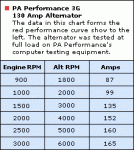My '87 B2 with 123,000 miles seems to have a weak alternator and electrical system (battery is fine). When the revs go up a bit, the headlights get significantly brighter, and the window motors work faster etc. than when at idle.
I was looking at the 40W, 60W 100W and 140W alternators available through LMC Truck and wondering if installing a 100W alternator would kick-up my overall electrical system performance? I will be replacing my old radio/cassette unit with a new CD player in the next few weeks, but do NOT have a loud system, and no electrical extras. Also, if I installed a 100W alternator and a high voltage coil, might I expect any noticeable or measurable performance improvement? In either power or gas mileage?
Any insight appreciated. Thanks.
CraigK
Some auto electric basics.
1. Alternators are rated by the maximum Amperage output they can produce at a given alternator RPM.
2. The alternator is intended to supply the entire electrical load once the engine is running.
3. Recharging the battery after starting the engine.
4. The battery is for:
A. starting the engine.
B. supplying current for devices when the engine is off (short term only).
C. keeping very low current devices going when the engine is off like the computer and clock.
D. when the engine is running, supplying
very short term loads that exceed the alternators ability
until the regulator can adjust the output.
What you could be seeing may be the result of a weak aging battery and/or alternator system. The reason for the change in brightness is that the alternator can not supply enough current (Amps) at low RPM to support all the load requirement. It is even possible that it isn't putting out at all at low RPM, (there are other possible factors but I'm not covering them right now). When you increase the engine RPM the alternator is able to put out more current and the load requirement is satisfied.
Now to answer your question. The advantages of a high output alternator are:
1. higher out put at engine idle RPM
2. the ability to supply loads not originally in the truck design, (like the new audio stuff).
3. the ability to recharge your battery while also supporting the other electrical loads
4. general overall improvement in supplying a full 12V to the loads like:
engine, lights, and equipment in the truck.
As far as your headlights, I would suggest a headlight harness upgrade. The advantage is that full voltage is supplied directly to the head lights over heavier wire that the original design.
If you are going to change alternators, I'd go for a 3G which has much better output at low RPM than what came in your truck. If you go for a 3G then you will need to increase the size of wire from the alternator to the battery and start relay.
Both changes are common improvements on the original and very simple to do. You can buy the headlight harness already built and is pretty much a Plug and Play installation. The 3G upgrade takes a little thought ahead of time, but is still very simple.
Attached is a output chart for a, "PA Performance", 3G alternator and is typical of what you will find for any manufacturers 3G alternator.
Hope that helps.
Good luck,

>-


